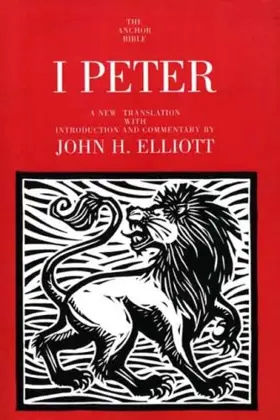

1 Peter
Pages
992
Publisher
Yale University Press
Published
1/1/2001
ISBN-13
9780300139914
The significance of the First Letter of Peter for the formation of Christianity stands in sharp contrast to its brevity. John H. Elliott, a leading authority on this letter, brings its significance to life in this magnificent addition to the renowned Anchor Bible Commentaries. Elliott sets the letter into context, covering its literary, historical, theological, and linguistic elements. In detailed, accessible discussions, he draws on the latest research to illuminate the social and cultural influences on the Church in its initial years. Treating such important Petrine concerns as living honorably in a hostile society, finding meaning in suffering, and resisting social assimilation as the elect and holy family of God, the translation, notes, and commentary in this volume will help readers appreciate the powerful and enduring message of this fascinating letter.
Collections
This book appears in the following featured collections.
- Favorite Advanced NT Commentaries by Jeremy Pierce (parableman)
- Recommended NT Commentaries by Denver Seminary Journal
- The Pastor’s Bookshelf by Scot McKnight
- New Testament Commentaries & Monographs by Princeton Theological Seminary
- Nijay Gupta's Top NT Commentaries by Nijay K. Gupta
- Recommended New Testament Commentaries for Evangelical Pastors by Thomas R. Schreiner
Reviews
Nearly a thousand pages long commentary by the premiere modern Petrine scholar, a Lutheran who taught for decades at the Jesuit-run University of San Francisco. Even though it is older than the excellent commentaries by Forbes and Jobes, this one remains an absolute must for serious exegetical study of the epistle
[Full Review]
At over 900 pages, Elliot’s commentary on 1 Peter has to be one of the longest written on a short book. The introduction runs to 304 pages alone, half of which is bibliography. For Elliot, 1 Peter was written sometime between A. D. 73 and 95 by someone who was associated with Peter, probably living in Rome. Consequently, he understands the readers as a mixed audience of Jewish and Gentile Christians. The language of the first verse as using Jewish language to describe the increasingly Gentile church. This commentary is one of the first in recent years to take the “resident alien” language literally, seeing it as an allusion to people who are outside of Roman society. This status as “resident alien” makes them susceptible to persecution. The commentary itself follows the Anchor Bible pattern by offering a fresh translation followed by detailed notes on the English text. In this case, the notes proceed almost word-by-word through the book, with Greek in transliteration. Elliot is masterful at drawing out allusions to other texts; virtually the whole of Greco-Roman and Second Temple Period Jewish literature is mined for potential allusions or parallel texts in 1 Peter. Occasionally he offers “Detailed Notes” (an excursus) on a particular point. This commentary will challenge readers, but it is worth the effort – all later writers on 1 Peter will have to take Elliot’s views into consideration.
[Full Review]
No commentary is as complete as JH Elliott on 1 Peter, and it is the result of a career of studies on the letter.
[Full Review]
Chestnut Hill, Massachusetts By taking on the Anchor Bible commentaries and related volumes, Yale University Press has assured the survival of this hallmark series of scholarly volumes. The sturdily bound paperbacks stand up to backpack transit and ink pen notations. Students should be less reluctant to acquire (and read) the new format. Professor Elliott has devoted much of his scholarly career to analyzing the social and theological context of 1 Peter. This commentary represents over a decade of work. It provides a detailed account of previous interpretations of the epistle from the third century through the late 1990s. Maps illustrate Asia Minor in the Flavian period (69–96 C.E.), Mediterranean trade routes, and the hypothetical route that Silvanus, the letter’s courier (1 Pet 5:12), took from Rome through the cities in Asia Minor. Elliott sticks to the format established by the long commentaries in the series. After an introduction treating genre, sources, language, composition, authorship and date, addressees, context, theological motifs, and canonicity, each section follows the same pattern. The author’s translation of the passage is followed by an introduction to its literary structure, detailed exegetical notes to each verse, phrase by phrase, and general and detailed comment sections. Detailed comments permit the author to defend his solution to complex problems and later theological teaching attached to 1 Peter.
[Full Review]






